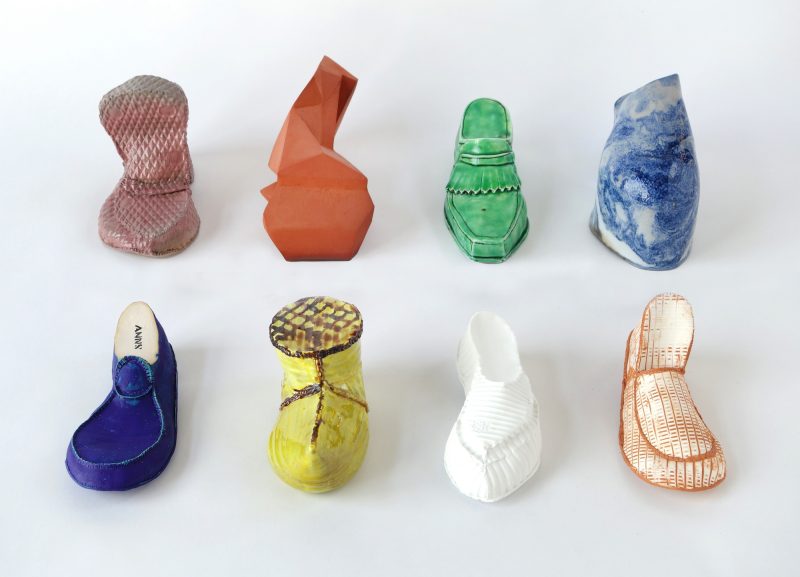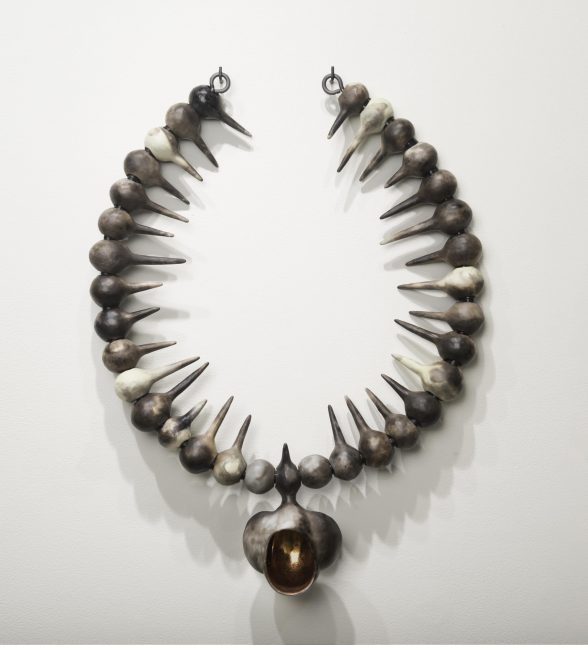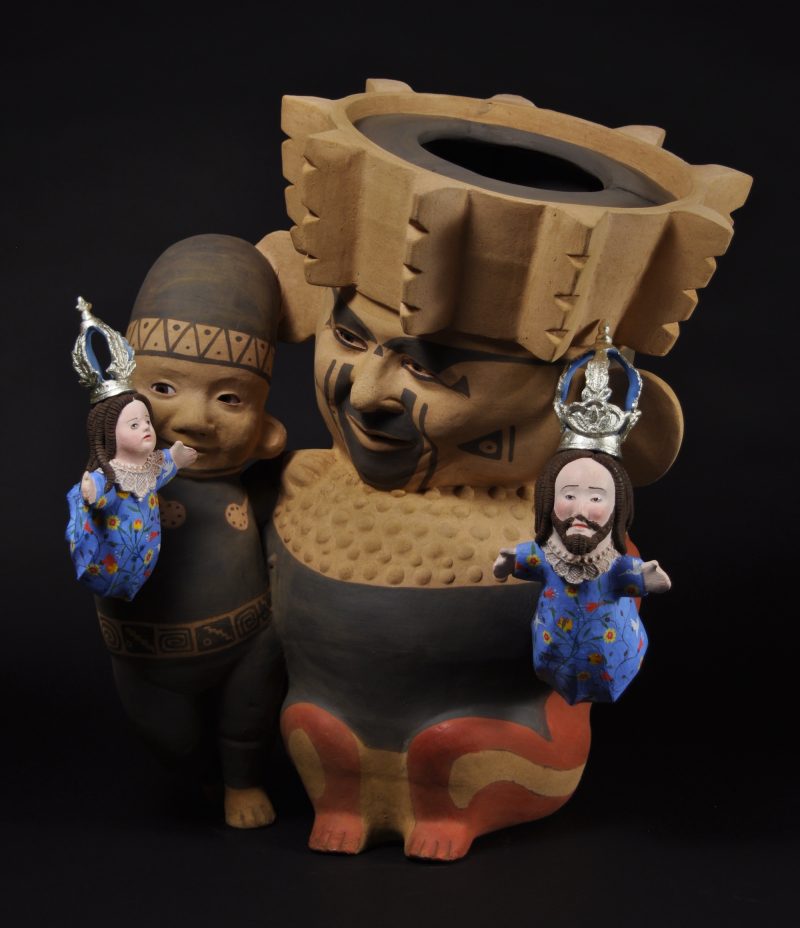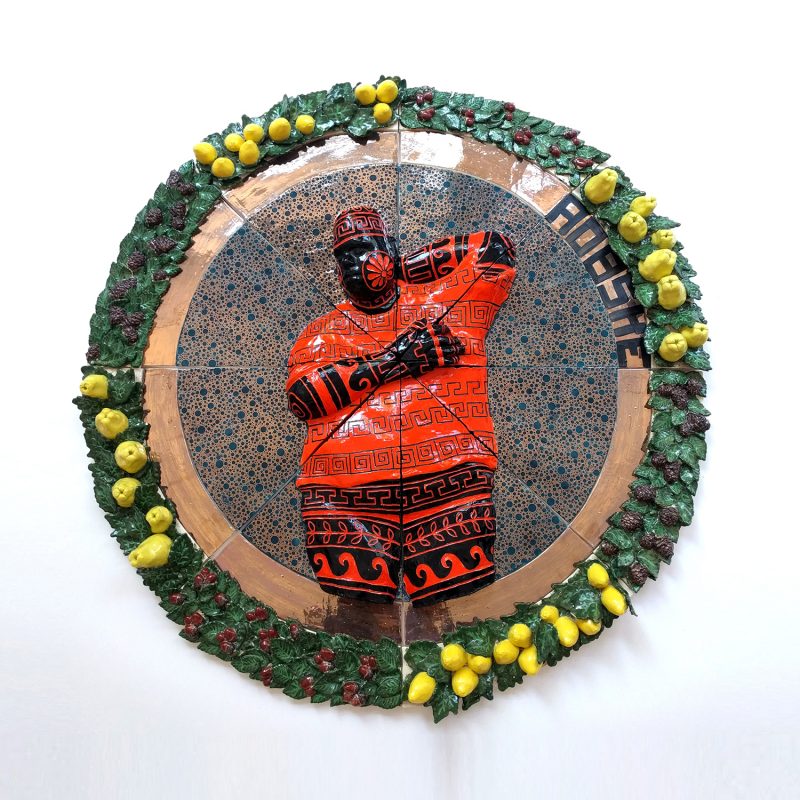“All I have is a voice
To undo the folded lie”
— From “September 1, 1939”, W.H. Auden
This exhibition asks whether art, and here ceramic art, can “make a difference” as a response to, and a protest against, what we might as well just describe in shorthand as the evils of Trumpism. I think that this is an important question to ask when so many of us in the opposition have been struggling, often in vain, to find ways to do just that, lest we become complicit in the degenerative political culture being thrust upon us.
While I firmly believe in the salutary effects of art, it’s questionable whether artists explicitly representing their political views in their work can make a difference. And here, by “making a difference,” I mean, among other things, communicating in a meaningful way to those who disagree with their viewpoints. It’s easy, of course, to fall into the trap of preaching to the choir, and easier even to end up ridiculing the other side, especially today. But to what end? To laugh until you cry?
Are we just canaries in a coal mine?
The works on view, by thirteen artists,* run the gamut from the parodic to the sublime. In one, a coven of yellow canaries perched on a wall face away from the viewer, as if they are trying to get away. The piece, by Tim Berg and Rebekah Myers, is called “Turn a Blind Eye.” Across from the installation is their circular neon sign which reads “THIS WAY LIES MADNESS LIES,” reminiscent of Bruce Nauman’s “The True Artist Helps the World by Revealing Mystic Truths” at the PMA. My thought: now in the hands of a government dominated by climate change deniers, we have all become canaries in a coal mine.
Move the polling places to museums and galleries and vote on weekends
In the face of voter apathy and suppression, the opposition at this moment in our political history has been reduced to trying to get out the vote. There’s something tragic, even pitiful about that, albeit important, and the exhibit takes note of the fact in an unsubtle work by Russell Biles in which scores of horrible-looking, hand-sized, bloody pink clay Trumps and Putins and Kim Jong-uns and Assads, et al. (I think a Kavanaugh was thrown in at the last minute), with diminutive hands and genitals, fangs and pig ears, some with little horns, many of which look like they have metallic instruments of torture shoved in their mouths, stand in rows upon a large black platform that reads VOTE. It’s a disgusting piece, but then again it’s a disgusting situation. So ok, vote.
The adornment and subjugation of women

On the sublime end of the spectrum, there is a wonderful group of objects by Ann Agee in the show, pictured here, small, lovely clay shoes or slippers which actually are hand warmers, copies of 17th and 18th century Davanzati majolica hand warmers that were shaped like shoes and used by women in Florence who were trapped in their houses, perhaps making lace, in rooms decorated to resemble the outside world, because it was allegedly too dangerous for them to go outside. Foot binding in China, of course, comes to mind, where adornment and subjugation meet in stunted feet.
The handmade world
As with other pieces in this exhibition, and perhaps together with craft arts generally, Agee’s work also directs our attention to what she refers to as “the eroding territory of the handmade world.” Thinking about this, I wondered whether these artists, and craftspeople generally, “make a difference” by counteracting or resisting the pressures of commercialism and mass production, of cheap consumption and waste, and absorption in the virtual world. Is there not some way in which making stuff, and doing things in the natural world, generates something that is in short supply in today’s political atmosphere — respect for the environment, for ourselves, and for each other?

Sharif Bey is an artist who takes homemade literally. He works at home in order to allow himself to avoid institutional structures and workplaces, to spend more time with his family, and to reflect in his work the milieu in which he lives. His unique piece “Gold Bird #4,” in the form of a necklace, transcends traditional ceramic production and presents a striking combination of beauty and power. Its earthy, gourd-like components resemble rattles; they are sharp and soft at the same time; and its hearth-like pendant is a window into the world beyond.
Syd Carpenter, Kukuli Velarde and Robert Lugo: Identity & Sustainability
There are two elegant pieces by Swarthmore professor Syd Carpenter in the show, which continue some of the work she exhibited at the African American Museum in 2014, which we reviewed. The work is part of her series of farm portraits, which celebrate the means, forms and structures of the farms and gardens of African Americans who, in the face of institutionalized racism and discrimination, are striving for self-sustainability, productivity and beauty, oftentimes now through urban gardening which brings their communities together. By this celebration, Carpenter “makes a difference” in our perception of what is valuable and sustainable, about what it takes to survive in an amoral and unequal society.

Making a Difference includes a piece, “San José y El Niño,” by the well known Peruvian-American artist Kukuli Velarde. We have written about her work before, and interviewed her on Artblog Radio. Her work is, I think, an exquisite expression of identity in a form that is not corrupted by colonization, by forces of assimilation intended to destroy the remnants of an indigenous or foreign culture. She “makes a difference” because in essence her work is about resurrecting and sustaining pride in the face of forces which would otherwise repel and reject those who are different.

Roberto Lugo has two pieces in the exhibition. We’ve written a great deal about this remarkable artist, most recently about his contribution to the Taller Puertorriqueño homecoming show. The signature piece of “Making a Difference” may be his gorgeous plate “New Slaves: The Cycle Continues.” The title itself speaks volumes about the messages conveyed in his work, in which he intends “to honor people of color.” Beholding the figure that dominates this work, which invokes the patterns of an African heritage together with the orange jumpsuits of mass incarceration in the United States, you almost feel as if Lugo has magically condensed histories of oppression and identity and walked them into the present.
I’ve often thought that Lugo’s work is about esteem, about the self-esteem of oppressed people of color. In the catalogue that accompanies the exhibit he states: “I often feel like my career is a practice of putting my face in a place it doesn’t belong.” I wonder whether that really is the recipe for “making a difference.”
Is there hope?
After all, I can’t help but circle back to the question I asked at the beginning: Who’s watching? Are these artists (together with the rest of us) just whistling in the dark? Much of the work on display in the exhibition conveys hope. Lamentably, I wonder whether the message is least likely to reach those who need most to hear it.
*Artists in the show: Ann Agee, Tim Berg & Rebekah Myers, Sharif Bey, Russell Biles, Mark Burns, Syd Carpenter, Ayumi Horie, Robert Lugo, Richard Notkin , Mara Superior, Kukuli Velarde Paula Winokur
Making a Difference: Social and Political Activism in Clay,The Clay Studio, 139 N 2nd St, through November 17th.





